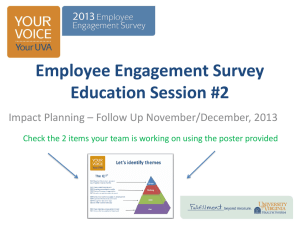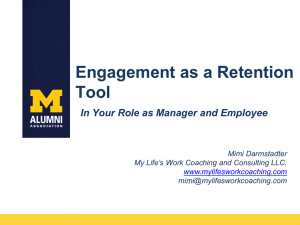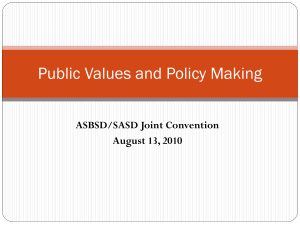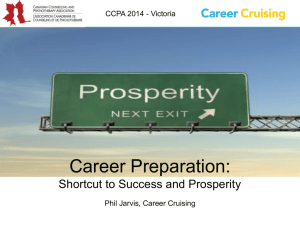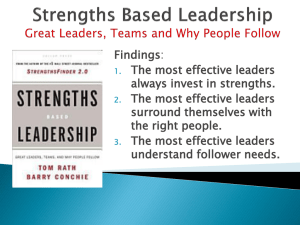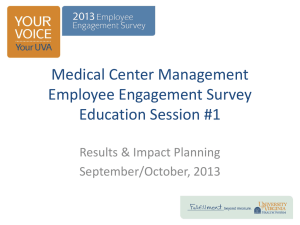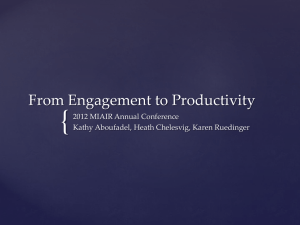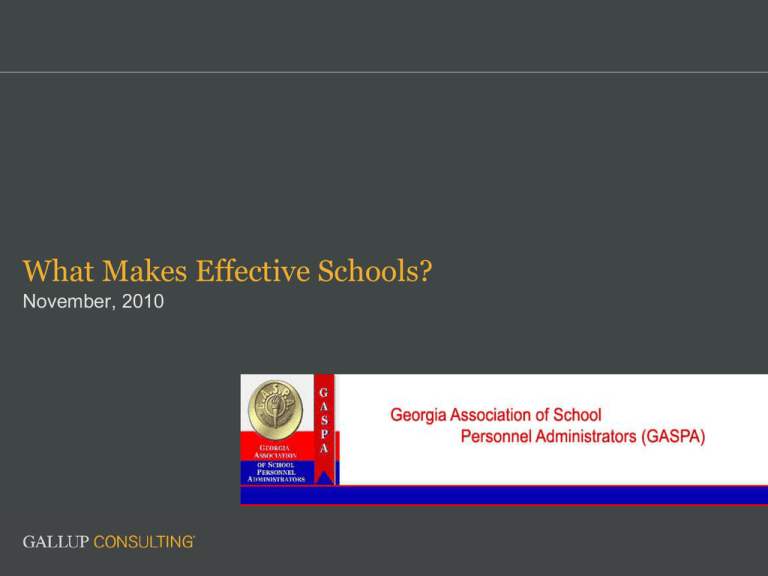
What Makes Effective Schools?
November, 2010
Copyright Standards
This document contains proprietary research, copyrighted materials, and literary property of Gallup, Inc. It is for the
guidance of your company only and is not to be copied, quoted, published, or divulged to others outside of your
organization. Gallup®, PrincipalInsight™ and Clifton StrengthsFinder® are trademarks of Gallup, Inc. All other
trademarks are the property of their respective owners.
This document is of great value to both your organization and Gallup, Inc. Accordingly, international and domestic
laws and penalties guaranteeing patent, copyright, trademark, and trade secret protection protect the ideas, concepts,
and recommendations related within this document.
No changes may be made to this document without the express written permission of Gallup, Inc.
Copyright © 2010 Gallup, Inc. All rights reserved.
2
The Assumptions
1. Selecting and developing teachers and principals on the basis
of their knowledge and skills is the most reliable way to
promote student success.
2. Focusing on and improving areas of weakness for students and
teachers is the key to making them more successful.
3. Differences in workplace culture are largely irrelevant to
schools, because a teacher’s working environment doesn’t
make much difference in the classroom.
Copyright © 2010 Gallup, Inc. All rights reserved.
3
Earning an “A” Grade
In your opinion, what are the main things a school has to do before it
can earn an “A”? (Open-ended question)
12%
12%
6%
5%
June 4-28, 2010
Phi Delta Kappa/Gallup poll
Copyright © 2010 Gallup, Inc. All rights reserved.
4
Student Success , Teacher and Principal Effectiveness
Talent
Student
Achievement
Principal
Effectiveness
Teacher
Effectiveness
Student
Hope,
Engagement,
Well-Being
Professional
Development
Teacher
Engagement
Curriculum &
Instruction
Fit
Copyright © 2010 Gallup, Inc. All rights reserved.
5
Human Capital: People and Performance
Copyright © 2010 Gallup, Inc. All rights reserved.
6
Attracting and Selecting for Excellence
Copyright © 2010 Gallup, Inc. All rights reserved.
7
Hiring Considerations
Masters
Degree
Fit with
District
Hiring for:
– Subject-Matter
Knowledge
– Teaching Experience
– Skills
– Masters Degree
– Fit with
– District
– Principal/Team
Skills
Fit with
Principal/
Team
Teaching
Experience
Subject-matter
knowledge
Copyright © 2010 Gallup, Inc. All rights reserved.
8
What Makes a Difference in Student Achievement?
Buddin, (2010)
– Subject-Matter
Knowledge
– Teaching Experience
– Skills
– Masters Degree
– Fit with Principal/Team
Teacher experience
Degrees beyond bachelor’s
degree
Different grade levels
Class size
Student backgrounds
(income, educ.)
Rivkin, et al. (2005)
Jacob & Lefgren (2008)
Harris & Sass (2006)
Aaronson et al. (2008)
Koedel & Betts (2007)
Clotfelter et al. (2007)
– Talent
Copyright © 2010 Gallup, Inc. All rights reserved.
9
Elements of Great Teaching
How
Who
What
Parker Palmer, 1998. The Courage to Teach
Copyright © 2010 Gallup, Inc. All rights reserved.
10
Strengths Development
Copyright © 2010 Gallup, Inc. All rights reserved.
11
The Assumption
Focusing on and improving areas of weaknesses for
students and teachers is the key to making them more
successful.
Copyright © 2010 Gallup, Inc. All rights reserved.
12
How does development improve performance?
Identify and work on weaknesses?
Identify and work on strengths?
Percent Responding
100
75
52
45
50
25
0
Gallup Poll, n= 1,016
Weaknesses
Strengths
Copyright © 2010 Gallup, Inc. All rights reserved.
13
Manager’s Focus
100%
2
90%
80%
70%
45
61
58
60%
Engaged
50%
Not Engaged
40%
33
Actively Disengageed
30%
20%
40
38
22
10%
1
0%
Ignored
Weakness
1: 100
Strengths
Copyright © 2010 Gallup, Inc. All rights reserved.
14
Investing in Students
When a teacher discusses your performance with you, do you spend more
time talking about building your strengths or improving your weaknesses?
Gallup Student Poll, March 2009
Copyright © 2010 Gallup, Inc. All rights reserved.
15
Strengths in K-12 Schools
Midwestern Alternative Education High School
Overall satisfaction with setting
30%
20%
18%
10%
No Strengths
0%
Strengths
-10%
-20%
-19%
-30%
Tyler, J. (2006). The impact of strengths-based development on student engagement. Unpublished doctoral
dissertation, Texas Christian University, Ft. Worth, TX .
Copyright © 2010 Gallup, Inc. All rights reserved.
16
Schools and Strengths
“My school is committed to building the
strengths of each student.”
82% of the students who strongly agree are engaged.
Gallup Student Poll, March 2010 n-122,579
Copyright © 2010 Gallup, Inc. All rights reserved.
17
Strengths and the First Parent Conference
Start with the student as a person
What are his/her interests outside of school?
What are his/her interests in school?
What is the best way to motivate him/her?
What is the best way for me to recognize him/her?
How does he/she deal with disappointment? What do you do to
help him/her deal with disappointment?
Once you know more about the student, you can share the
grade book and discuss the partnership you need from the
parent(s).
Copyright © 2010 Gallup, Inc. All rights reserved.
18
What is Engagement?
Copyright © 2010 Gallup, Inc. All rights reserved.
19
The 12 Elements of Engaged Workplaces
I know what is expected of me at work.
I have the materials and equipment I need to do my work right.
At work, I have the opportunity to do what I do best every day.
In the last seven days, I have received recognition or praise for doing good work.
My supervisor, or someone at work, seems to care about me as a person.
There is someone at work who encourages my development.
At work, my opinions seem to count.
The mission/purpose of my company makes me feel my job is important.
My associates (fellow employees) are committed to doing quality work.
I have a best friend at work.
In the last six months, someone at work has talked to me about my progress.
This last year, I have had opportunities at work to learn and grow.
Copyright © 2010 Gallup, Inc. All rights reserved.
20
American Workforce Engagement Levels
29%
Engaged
51%
Not Engaged
20%
Actively
Disengaged
*Source: 2009 Gallup Poll data of U.S. working population 18 years and older
Copyright © 2010 Gallup, Inc. All rights reserved.
21
22
Copyright © 2006 The Gallup Organization, Princeton, NJ. All rights reserved.
®
12
Q
Meta-Analysis: Outcomes
Difference between top and bottom
quartiles
Turnover
Patient
High
Low
Absen- Turnover Turnover ShrinSafety
Safety
teeism
Orgs.
Orgs.
kage Incidents Incidents
Quality
(Defects)
Customer
Profitability
Productivity
Copyright © 2010 Gallup, Inc. All rights reserved.
23
Student Engagement
Could we identify student engagement items
with relationships to student achievement on
state proficiency tests?
Complete data on 160 schools, 8,341 teachers,
78,106 students (grades 5-12)
Copyright © 2010 Gallup, Inc. All rights reserved.
24
Model of Engagement and Student Achievement
Level
Number of Students
Teacher
Engagement
Student
Engagement
Student
Achievement
Reading
Math
r2= .58
r2= .64
Free and Reduced
Lunch
Copyright © 2010 Gallup, Inc. All rights reserved.
Gallup Student Poll
Hope
intelligence, aptitude, income
credits earned, GPA in high school
in college, better predictor of college success
than high school GPA, SAT, ACT
Engagement
reading achievement
math achievement
science achievement
Well-Being
more credits earned in high school
higher GPA
Copyright © 2010 Gallup, Inc. All rights reserved.
26
Gallup Student Poll
Administered in October each year
Surveys grades 5-12
Web survey requiring less than 10 minutes to complete
Score cards for the district and each school
No cost to the school or district for conducting the survey
and receiving results
Register at gallupstudentpoll.com
Copyright © 2010 Gallup, Inc. All rights reserved.
27
Gallup Student Poll National Scorecard – Summary
28
Copyright © 2010 Gallup, Inc. All rights reserved.
What Makes Effective Schools?
Leadership
Succession
Recruitment
and
Selection
Parent
Support
Student
Success
School
Conditions
for Students
Development
School
Conditions
for
Employees
Copyright © 2010 Gallup, Inc. All rights reserved.
29
Our Opportunity
Isn’t It Strange That Princes And Kings
And Clowns That Caper In Sawdust Rings
And Common People Like You And Me
Are Builders For Eternity?
To Each Is Given a Bag of Tools
A Shapeless Mass, a Book of Rules
And Each Must Build Ere Life Has Flown,
A Stumbling Block or a Stepping Stone
R. Sharpe
30

